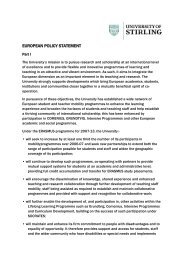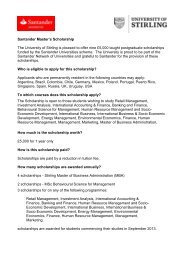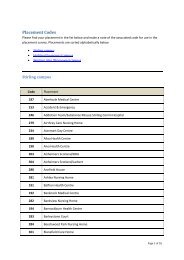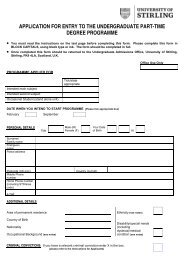Health First: An evidence-based alcohol strategy for the UK
Health First: An evidence-based alcohol strategy for the UK
Health First: An evidence-based alcohol strategy for the UK
Create successful ePaper yourself
Turn your PDF publications into a flip-book with our unique Google optimized e-Paper software.
<strong>Health</strong> <strong>First</strong>: an <strong>evidence</strong>-<strong>based</strong> <strong>alcohol</strong> <strong>strategy</strong> <strong>for</strong> <strong>the</strong> <strong>UK</strong><br />
The tax on every <strong>alcohol</strong> product<br />
should be proportionate to <strong>the</strong><br />
volume of <strong>alcohol</strong> it contains.<br />
In order to incentivise <strong>the</strong><br />
development and sale of lower<br />
strength products, <strong>the</strong> rate of<br />
taxation should increase with<br />
product strength.<br />
Regulation of <strong>alcohol</strong> promotion and products<br />
<strong>An</strong> independent body should be<br />
established to regulate <strong>alcohol</strong><br />
promotion, including product<br />
and packaging design, in <strong>the</strong><br />
interests of public health and<br />
community safety.<br />
All <strong>alcohol</strong> advertising and<br />
sponsorship should be<br />
prohibited. In <strong>the</strong> short term,<br />
<strong>alcohol</strong> advertising should only<br />
be permitted in newspapers<br />
and o<strong>the</strong>r adult press. Its<br />
content should be limited<br />
to factual in<strong>for</strong>mation about<br />
brand, provenance and product<br />
strength.<br />
Alcohol producers should<br />
be required to declare <strong>the</strong>ir<br />
expenditure on marketing and<br />
<strong>the</strong> level of exposure of young<br />
people to <strong>the</strong>ir campaigns.<br />
The sale of <strong>alcohol</strong> products<br />
that appeal more to children<br />
and young people than to adults<br />
should be prohibited.<br />
At least one third of every<br />
<strong>alcohol</strong> product label should be<br />
given over to an <strong>evidence</strong>-<strong>based</strong><br />
health warning specified by an<br />
independent regulatory body.<br />
Every <strong>alcohol</strong> product label<br />
should describe, in legible type,<br />
<strong>the</strong> product’s nutritional, calorie<br />
and <strong>alcohol</strong> content.<br />
Throughout <strong>the</strong> <strong>UK</strong> duty on beer and spirits is proportionate to <strong>the</strong> volume of <strong>the</strong>ir<br />
<strong>alcohol</strong> content but duty on wine and cider is not. Instead it is applied in bands. For<br />
example, <strong>for</strong> sparkling wine, one rate is applied <strong>for</strong> wines of 5.5-8.5% strength and<br />
ano<strong>the</strong>r <strong>for</strong> wines of 8.5-15% strength. EU rules currently preclude a change in policy<br />
<strong>for</strong> wine and cider.<br />
No body of this kind currently exists.<br />
A voluntary code of practice on <strong>the</strong> Naming, Packaging and Promotion of Alcoholic<br />
Drinks was introduced by <strong>the</strong> <strong>alcohol</strong> industry’s Portman Group in 1996. The code is<br />
supported by <strong>the</strong> industry and is adjudicated by an independent complaints panel.<br />
The current <strong>UK</strong> regulatory system <strong>for</strong> <strong>alcohol</strong> advertising is a mixture of selfregulation<br />
<strong>for</strong> non-broadcast advertising and co-regulation <strong>for</strong> broadcast advertising.<br />
This regulatory system is maintained and paid <strong>for</strong> by <strong>the</strong> <strong>alcohol</strong> industry and<br />
en<strong>for</strong>ced by <strong>the</strong> Advertising Standards Authority (ASA). The ASA is <strong>the</strong> independent<br />
regulator <strong>for</strong> advertising, and is funded by a levy on advertising space. For TV and<br />
radio advertising, <strong>the</strong> ASA regulates under a contract from Ofcom, which operates<br />
under <strong>the</strong> Communications Act 2003 and is accountable to <strong>the</strong> <strong>UK</strong> Parliament.<br />
Current <strong>alcohol</strong> advertising regulation arrangements are described above. For<br />
sponsorship, <strong>the</strong> <strong>alcohol</strong> industry has a code of practice (<strong>the</strong> Portman Group’s) that<br />
stipulates that people aged under 18 years should not comprise more than 25% of<br />
<strong>the</strong> participants, audience or spectators at events sponsored by <strong>the</strong> <strong>alcohol</strong> industry.<br />
In addition, <strong>alcohol</strong> producers are unable to display <strong>the</strong>ir company’s branding on<br />
children’s replica sports shirts under sponsorship agreements signed after 1 January<br />
2008.<br />
In Nor<strong>the</strong>rn Ireland, a consultation launched by <strong>the</strong> Minister <strong>for</strong> Social Development<br />
addresses restrictions on <strong>the</strong> advertising of <strong>alcohol</strong> in supermarkets and off-sales<br />
premises, or within 200m of <strong>the</strong>se premises.<br />
No arrangements <strong>for</strong> this type of declaration are currently in place.<br />
The <strong>alcohol</strong> industry’s own code of practice (from <strong>the</strong> Portman Group) states that<br />
products should not have ‘particular appeal’ to under 18s. In addition, product<br />
packaging should not incorporate images of individuals who are, or look as if <strong>the</strong>y<br />
are, under 25 years of age.<br />
It is not currently compulsory <strong>for</strong> <strong>alcohol</strong> product packaging to state <strong>the</strong> <strong>alcohol</strong> unit<br />
content of <strong>the</strong> product or carry a health warning.<br />
At <strong>UK</strong> level, <strong>the</strong> <strong>alcohol</strong> industry pledged through <strong>the</strong> ‘Responsibility Deal’ that,<br />
by December 2013, 80% of products would have at least some labelling and that<br />
this would contain a minimum of three elements: unit content, sensible drinking<br />
guidelines and a warning on <strong>alcohol</strong> consumption in pregnancy. No commitments to<br />
size or prominence of this labelling have been made.<br />
These requirements are not currently in place. The terms ‘non-<strong>alcohol</strong>ic’ and ‘low<br />
<strong>alcohol</strong>’ are defined in law but from 13 December 2014 this will no longer be <strong>the</strong><br />
case.<br />
45
















